
Station Name: EMBLETON[Source: Alan Young]
Embleton Station Gallery 1: c1910 - August 1962
 A North Eastern Railway 1001 Class 0-6-0 locomotive No.1183 hauling mineral waggons through Embleton station c1910. The CK&P originated principally as a route to convey pig iron and iron ore from west Cumberland to industries in County Durham and Yorkshire and coal in the opposite direction. Eighteen months after the CK&P opened (1865) the NER’s Redhills curve enabled their trains to avoid a reversal at Penrith. Single line tokens are being exchanged between the stationmaster and engine crew. The 1001 Class originated in 1852, but the class underwent modification and rebuilds; for instance on this example the cab roof is rounded in the style favoured by Edward Fletcher (Locomotive Superintendent of the NER 1854-1882). The signal is an LNWR slotted post bi-directional type which at one time was quite common. They had the advantage of requiring less equipment, for example just a single post.
Photo from Cumbrian Railway Association and Darlington North Road Railway Museum  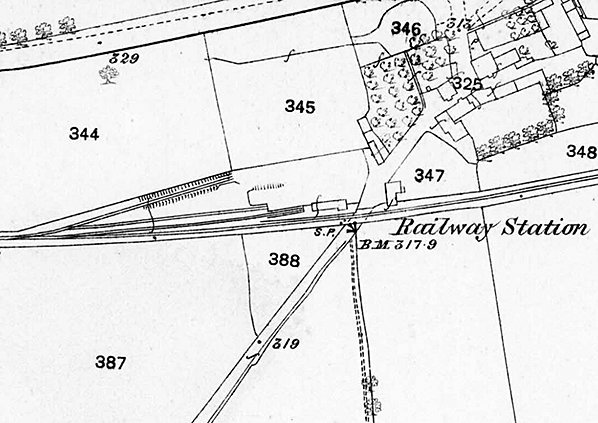
1864 1: 2,500 OS map. Rather than being given its name of Embleton, ‘Railway Station’ implies that it is called Lambfoot; early CK&P minutes refer to the station as being at Lambfoot / Lamb Foot, but the name of Embleton had been decided upon in 1864. The platform and station building are on the north (up) side of the single-track railway, immediately west of the level crossing. The stationmaster’s house is on the same side of the line but east of the crossing. Three goods sidings are shown north of the platform and a goods loading bank is indicated.

1900 1: 2,500 OS map. The station is now named. There have been significant changes in the goods department. The siding layout has been altered and a rail-served saw mill and its timber yard have appeared on the site. The weigh depot (‘W.M.’ = weighing machine) and a water pump (‘P’) are shown.
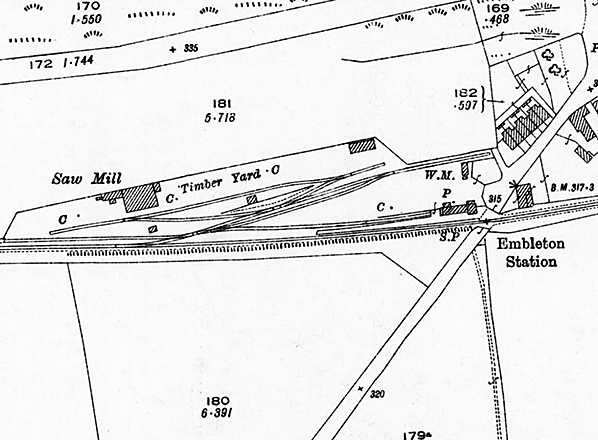 1925 1: 2,500 OS map. A new, larger saw mill has been built west of the earlier site and the layout of associated sidings has been extended. Three cranes are installed in the timber yard, and a further crane (1 ton 15cwt capacity)is shown in the goods yard. The small addition to the north side of the station building is the gas house, where the acetylene gas to illuminate the station’s lamps is generated
. 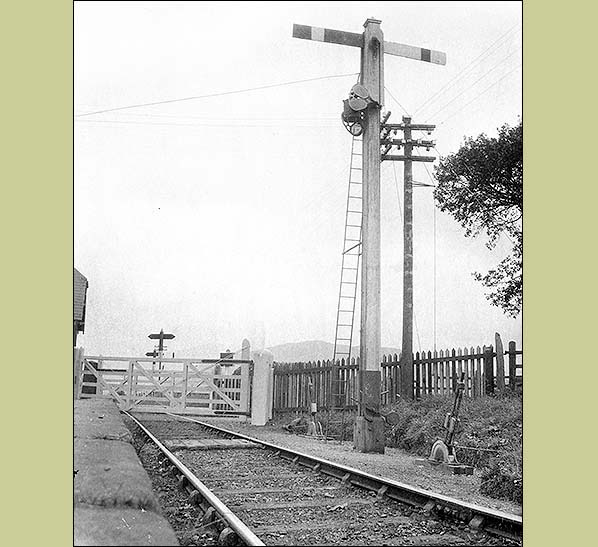
Embleton station looking east towards the level crossing from the platform. Note the LNWR slotted-post bi-directional signal. They were quite common with some lasting into the 1960s. That at Embleton was replaced at an unknown date, probably by the LMS, by two conventional lower-quadrant signals one either side of the level crossing. That on the station side of the crossing had a concrete post and remained in situ until the line was dismantled. That on the other side of the crossing was replaced by an upper-quadrant signal on steel post (see both below), this also remaining until the line was dismantled
Photo from Duncan Chandler collection from his Flickr photostream 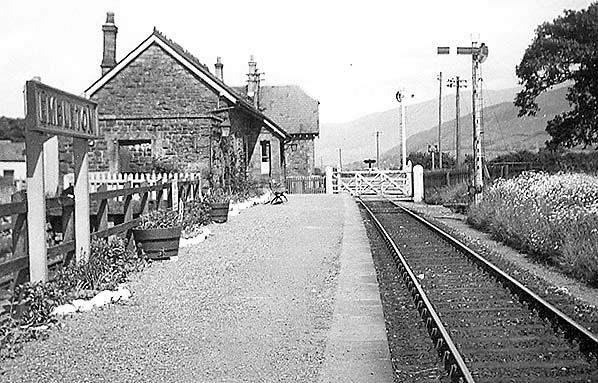
Embleton station looking east c1950. This station, like Braithwaite, possessed only a single platform and there was no passing loop. The single-storey station building is a standard CK&P design seen at several other minor stations on the route including Braithwaite and Penruddock. It is notable for the forward projection of the station office, allowing staff to have an unobstructed view of the platform. The stationmaster’s two-storey house is beyond the level crossing. The nameboard is probably an early LMS design. A modest station garden can be seen at the back of the platform including some tubs and white stones. Separate signal posts for up and down traffic are now provided.
Photo from Alan Young collection 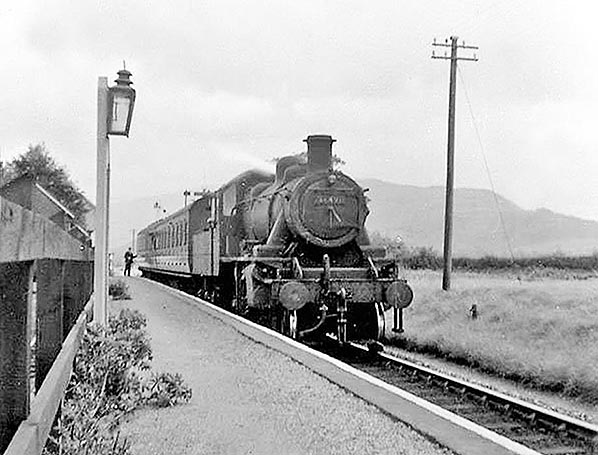
In the mid 1950s Ivatt Class 2F 0-6-0 No.46488 is seen at Embleton station bound for Keswick and Penrith. The locomotive was built in 1951 and spent its life at 12D, Workington shed until it was withdrawn in 1965. It was a regular visitor to the line throughout its working life.
Photo from James Lake collection 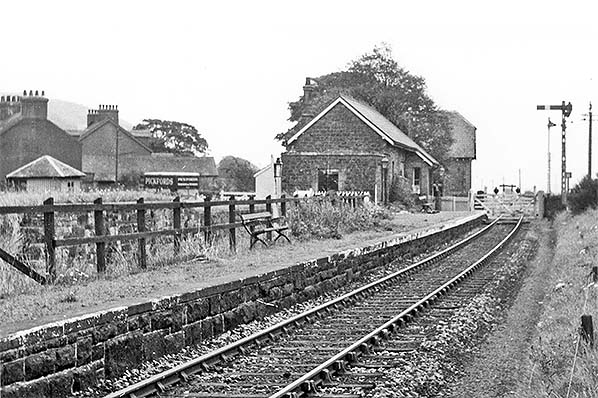 Although Embleton was an early casualty, closing to all traffic in September 1958, the station remained intact until the line closed in 1966 and the level crossing continued to be attended. However, in this view from October 1961 the station garden is no longer maintained and weeds are colonising the platform. Behind the platform the abandoned goods loading bank and weigh office are visible.
Photo from John Mann collection 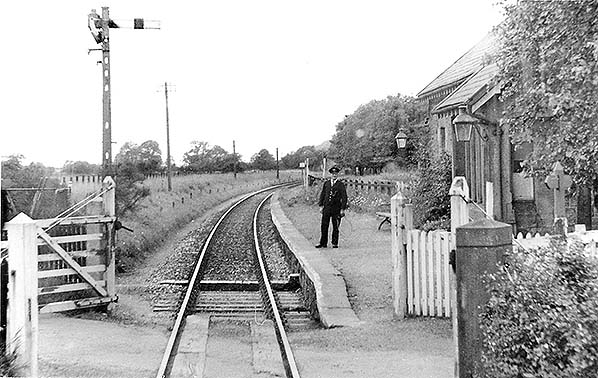
In August 1962 Embleton station is seen from the driver’s cab of a down train between Keswick and Cockermouth. Although the station has been closed to all traffic since 1962 it remains in good order. The platform is still used by railway staff to exchange single-line tokens with the drivers – the railwayman can be seen holding the token for the section of line westward towards Cockermouth – and the tablet instruments are located in the office (the near end of the building). Casement lanterns are still attached to the building.
Photo from John Mann collection Click here for Embleton Station Gallery 1: c1964 - 2018
|
 The station buildings, platform and goods sidings were on the up (north) side of the single line, all structures except for the stationmaster’s house being west of the level crossing. The station building, located adjacent to the crossing, was similar to those at Penruddock, Troutbeck and Braithwaite, being a single-storey stone edifice under a pitched roof. At the eastern end the office stood forward to provide the staff with a clearer view of the platform. From c1890s tablet instruments were installed in the office so that a goods train could take refuge in the yard while a passenger train used the running line; passenger trains could not cross at the station. Signals were operated from an open ground frame at the level crossing.
The station buildings, platform and goods sidings were on the up (north) side of the single line, all structures except for the stationmaster’s house being west of the level crossing. The station building, located adjacent to the crossing, was similar to those at Penruddock, Troutbeck and Braithwaite, being a single-storey stone edifice under a pitched roof. At the eastern end the office stood forward to provide the staff with a clearer view of the platform. From c1890s tablet instruments were installed in the office so that a goods train could take refuge in the yard while a passenger train used the running line; passenger trains could not cross at the station. Signals were operated from an open ground frame at the level crossing.
 At the ‘Grouping’ in 1923 ownership and operation of the line passed to the London, Midland & Scottish Railway (LMS). In 1926 the nearby saw mill, by this time owned by Mr T Rutherford, was closed and the connecting siding was removed in 1929. Timber continued to be handled in the goods yard, albeit in declining quantities; in World War 2 the timber traffic revived to provide timber for pit props, the wood coming from local Forestry Commission plantations. Under LMS ownership Embleton station remained essentially Victorian in appearance, and there was no significant change in this regard following the transfer of administration to British Railways (BR) London Midland Region (LM) at nationalisation in 1948.
At the ‘Grouping’ in 1923 ownership and operation of the line passed to the London, Midland & Scottish Railway (LMS). In 1926 the nearby saw mill, by this time owned by Mr T Rutherford, was closed and the connecting siding was removed in 1929. Timber continued to be handled in the goods yard, albeit in declining quantities; in World War 2 the timber traffic revived to provide timber for pit props, the wood coming from local Forestry Commission plantations. Under LMS ownership Embleton station remained essentially Victorian in appearance, and there was no significant change in this regard following the transfer of administration to British Railways (BR) London Midland Region (LM) at nationalisation in 1948. 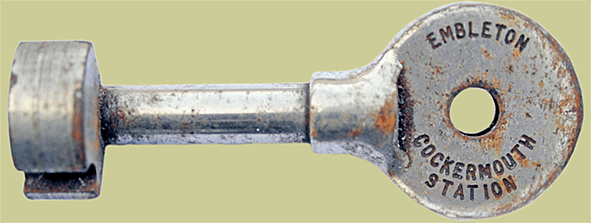
 The timetable shown above was to be the final one for Embleton station. Whilst three of the intermediate stations between Penrith and Workington (Blencow, Camerton and Workington Bridge) had been closed several years earlier by BR (Blencow subsequently reopening), Embleton had remained open despite its limited use. However Embleton was closed to all traffic on 15 September 1958. Probably anticipating its closure, BR appears not to have installed any modern signage and the elderly gas lighting remained in use until the end. Bowtell (1989) notes that after closure it was proposed to remove the instruments to the east-facing porch of the stationmaster’s house, relocate the ground frame on the lawn and convert the station building into a camping cottage, but that these alterations did not take place. Token exchange continued to be carried out at Embleton until the line closed in April 1966, and latterly this was undertaken by two women who were qualified to operate the instruments, ground frame and crossing gates and were in contact with the signalmen at Bassenthwaite Lake and Cockermouth.
The timetable shown above was to be the final one for Embleton station. Whilst three of the intermediate stations between Penrith and Workington (Blencow, Camerton and Workington Bridge) had been closed several years earlier by BR (Blencow subsequently reopening), Embleton had remained open despite its limited use. However Embleton was closed to all traffic on 15 September 1958. Probably anticipating its closure, BR appears not to have installed any modern signage and the elderly gas lighting remained in use until the end. Bowtell (1989) notes that after closure it was proposed to remove the instruments to the east-facing porch of the stationmaster’s house, relocate the ground frame on the lawn and convert the station building into a camping cottage, but that these alterations did not take place. Token exchange continued to be carried out at Embleton until the line closed in April 1966, and latterly this was undertaken by two women who were qualified to operate the instruments, ground frame and crossing gates and were in contact with the signalmen at Bassenthwaite Lake and Cockermouth.


 Home Page
Home Page